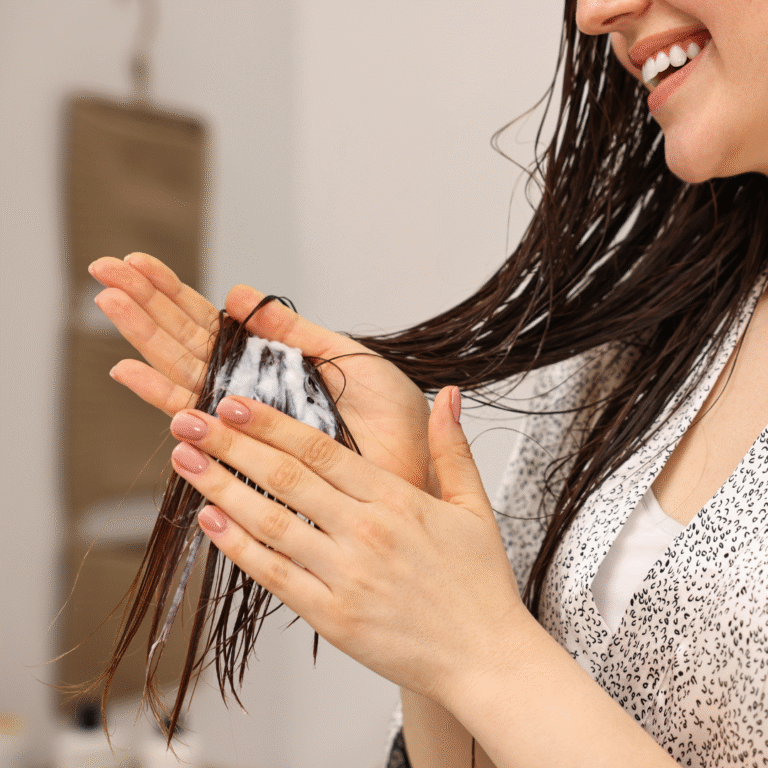How to Choose the Right Shampoo & Conditioner for Your Hair Type
Your hair is your crown — but choosing the wrong shampoo or conditioner can turn that crown into a mess. With so many products lining the shelves, it’s easy to feel overwhelmed. Should you go for “hydrating,” “clarifying,” “sulfate-free,” or “volumizing”? The truth is, the best shampoo and conditioner for you depends entirely on your hair type, scalp condition, and even your lifestyle.
In this blog, we’ll guide you step-by-step to understand your hair type and how to choose products that nourish, protect, and enhance your natural hair.

Why the Right Hair Products Matter ?
Many people grab hair care products based on advertisements, scent, or price — but this can damage your hair over time. Using the wrong shampoo or conditioner may lead to:
- Hair fall
- Scalp irritation or dandruff
- Greasy or dry texture
- Product buildup
- Dullness and breakage
The right products can restore balance, promote growth, and even repair years of damage. Let’s break it down.
How to Identify Hair Type
Before you buy any hair product, understand what kind of hair you have:
1. Oily Hair & Scalp
Feels greasy or flat by end of the day. Requires frequent washing.
What to use:
Go for a clarifying or balancing shampoo. Look for ingredients like tea tree oil, salicylic acid, or charcoal. Avoid creamy or hydrating formulas.
Conditioner tip:
Apply conditioner only to the ends, not the scalp.
2. Dry or Damaged Hair
Feels rough, brittle, or has split ends. Tends to frizz or look dull.
What to use:
Choose moisturizing shampoos with ingredients like argan oil, coconut oil, keratin, or shea butter. Avoid sulfates.
Conditioner tip:
Use a deep conditioner once a week. Leave-in conditioners also help.
3. Normal Hair
Balanced, manageable, not too oily or dry.
What to use:
You’re lucky! Use a gentle, pH-balanced shampoo. Look for labels that say “daily use” or “for all hair types.”
Conditioner tip:
Choose lightweight conditioners with vitamins or aloe vera for overall nourishment.
4. Curly or Wavy Hair
Tends to be dry and frizzy. Needs moisture and curl definition.
What to use:
Go sulfate-free. Look for curl-enhancing or moisturizing shampoos with ingredients like glycerin, jojoba oil, or silicone-free options.
Conditioner tip:
Opt for heavy, creamy conditioners that define curls and reduce frizz.
5. Thin or Fine Hair
Lacks volume, gets weighed down easily. Appears flat after styling.
What to use:
Choose a volumizing or thickening shampoo. Avoid heavy oils or creamy formulas.
Conditioner tip:
Use a lightweight conditioner and rinse thoroughly to avoid buildup.
6. Color-Treated or Chemically Treated Hair
Needs extra care to preserve color and reduce damage.
What to use:
Look for color-safe, sulfate-free shampoos. Use purple shampoo for blonde/grey tones.
Conditioner tip:
Go for protein-rich or color-protect conditioners with UV protection.
How to buy the right product

Decode the Labels
Shampoo and conditioner labels can be tricky. Here’s what common terms really mean:
- Sulfate-Free: Gentle on scalp; best for dry, sensitive, or colored hair.
- Clarifying: Deep cleans scalp; use once a week to remove buildup.
- Moisturizing/Hydrating: Best for dry, frizzy, or curly hair.
- Strengthening/Repair: Contains protein; ideal for damaged or weak hair.
- Volumizing: Adds lift; great for fine or flat hair.

Check the Ingredients
Good Ingredients to Look For:
- Keratin – Repairs damage
- Biotin – Strengthens and promotes growth
- Coconut oil/Argan oil – Hydrates and smooths
- Aloe vera – Soothes scalp
- Panthenol (Vitamin B5) – Adds shine and moisture
Ingredients to Avoid (especially for sensitive scalps or curly hair):
- Sulfates (SLS/SLES) – Can strip natural oils
- Parabens – Linked to irritation and hormone disruption
- Silicones – Can cause buildup (unless you clarify often)
- Artificial fragrances – May trigger allergies

Consider Natural Alternatives
If you prefer a natural routine, try organic shampoos and conditioners made with plant-based ingredients. Popular options include:
- Amla, Shikakai & Reetha – Traditional Indian herbs for cleansing.
- Tea Tree or Neem Oil – Great for dandruff and scalp care.
- Apple Cider Vinegar (ACV) – Restores pH and reduces frizz (when diluted).
But remember, “natural” doesn’t always mean better — test products carefully and check for irritants.

Trial & Observe
Everyone’s hair is different. What works for one person may not work for another. Here’s how to test:
- Use a new product for at least 2 weeks.
- Track how your hair feels after each wash.
- Adjust based on weather, season, and hair changes (e.g., post-pregnancy, aging).
Final Tips Before You Buy
If you suffer from chronic hair fall, dandruff, or scalp irritation, it’s worth consulting a hair specialist or dermatologist. Clinics often provide scalp analysis and recommend medical-grade shampoos suited to your hair needs.
Don’t be influenced by price or scent alone.
Stick to one brand at a time to avoid interactions.
Rotate products based on your scalp’s needs.
Avoid over-washing — 2–3 times a week is ideal for most.
Your hair deserves products that work with it — not against it. Whether you have dry curls or an oily scalp, choosing the right shampoo and conditioner can transform the health and look of your hair. Start by knowing your hair type, read the labels, and pick products thoughtfully. Healthy, happy hair starts in the shower!

